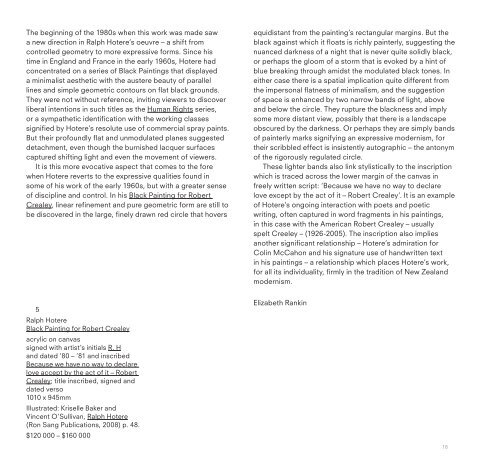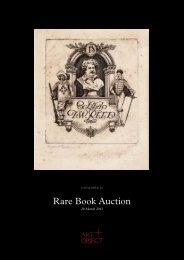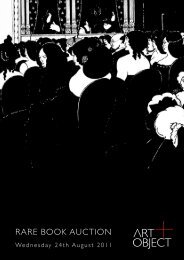Download PDF catalogue - Art+Object
Download PDF catalogue - Art+Object
Download PDF catalogue - Art+Object
You also want an ePaper? Increase the reach of your titles
YUMPU automatically turns print PDFs into web optimized ePapers that Google loves.
The beginning of the 1980s when this work was made saw<br />
a new direction in Ralph Hotere’s oeuvre – a shift from<br />
controlled geometry to more expressive forms. Since his<br />
time in England and France in the early 1960s, Hotere had<br />
concentrated on a series of Black Paintings that displayed<br />
a minimalist aesthetic with the austere beauty of parallel<br />
lines and simple geometric contours on flat black grounds.<br />
They were not without reference, inviting viewers to discover<br />
liberal intentions in such titles as the Human Rights series,<br />
or a sympathetic identification with the working classes<br />
signified by Hotere’s resolute use of commercial spray paints.<br />
But their profoundly flat and unmodulated planes suggested<br />
detachment, even though the burnished lacquer surfaces<br />
captured shifting light and even the movement of viewers.<br />
It is this more evocative aspect that comes to the fore<br />
when Hotere reverts to the expressive qualities found in<br />
some of his work of the early 1960s, but with a greater sense<br />
of discipline and control. In his Black Painting for Robert<br />
Crealey, linear refinement and pure geometric form are still to<br />
be discovered in the large, finely drawn red circle that hovers<br />
5<br />
Ralph Hotere<br />
Black Painting for Robert Crealey<br />
acrylic on canvas<br />
signed with artist’s initials R. H<br />
and dated ’80 – ’81 and inscribed<br />
Because we have no way to declare<br />
love accept by the act of it – Robert<br />
Crealey; title inscribed, signed and<br />
dated verso<br />
1010 x 945mm<br />
Illustrated: Kriselle Baker and<br />
Vincent O’Sullivan, Ralph Hotere<br />
(Ron Sang Publications, 2008) p. 48.<br />
$120 000 – $160 000<br />
equidistant from the painting’s rectangular margins. But the<br />
black against which it floats is richly painterly, suggesting the<br />
nuanced darkness of a night that is never quite solidly black,<br />
or perhaps the gloom of a storm that is evoked by a hint of<br />
blue breaking through amidst the modulated black tones. In<br />
either case there is a spatial implication quite different from<br />
the impersonal flatness of minimalism, and the suggestion<br />
of space is enhanced by two narrow bands of light, above<br />
and below the circle. They rupture the blackness and imply<br />
some more distant view, possibly that there is a landscape<br />
obscured by the darkness. Or perhaps they are simply bands<br />
of painterly marks signifying an expressive modernism, for<br />
their scribbled effect is insistently autographic – the antonym<br />
of the rigorously regulated circle.<br />
These lighter bands also link stylistically to the inscription<br />
which is traced across the lower margin of the canvas in<br />
freely written script: ‘Because we have no way to declare<br />
love except by the act of it – Robert Crealey’. It is an example<br />
of Hotere’s ongoing interaction with poets and poetic<br />
writing, often captured in word fragments in his paintings,<br />
in this case with the American Robert Crealey – usually<br />
spelt Creeley – (1926-2005). The inscription also implies<br />
another significant relationship – Hotere’s admiration for<br />
Colin McCahon and his signature use of handwritten text<br />
in his paintings – a relationship which places Hotere’s work,<br />
for all its individuality, firmly in the tradition of New Zealand<br />
modernism.<br />
Elizabeth Rankin<br />
18

















